Home (contents) → Miscellaneous → Rogallo wing definitions and diagrams
Rogallo wing definitions and diagrams
This page covers the Rogallo wing of the early 1970s. A defining characteristic of the Rogallo wing is that, much like the sails of a boat, its motion through the air keeps its shape — that shape being critical to its ability to fly.

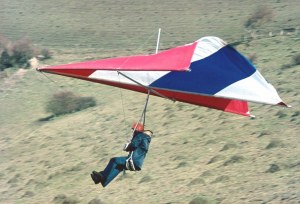
Modern flex-wing hang gliders are different in geometry and they are more complex, but nonetheless they have much in common with the early Rogallo wings.
Conical Rogallo

The sail of the most basic Rogallo wing, the conical Rogallo (more usually referred to as the standard Rogallo) consists, conceptually, of triangles cut from two overlapping cones.

The aerodynamic curve (camber) of the sail about half way out was reasonably good. However, at the root (the keel) it had no camber. At the tips the camber did not matter because of the washout (span-wise twist) and their tapering to a sharp point.

This diagram, first published in The Flypaper of the Alberta Hang Glider Association (Canada) goes some way to showing how a partial cone has an airfoil curve — at its mid semi-span at least.
The overwhelming simplicity, affordability, and transportability of the standard Rogallo — and that it worked! — more than made up for its aerodynamic deficiencies.
Cylindrical Rogallo
Geometrically, the cylindrical Rogallo consisted of triangular cut-outs from two cylinders side by side. In principle, it had no washout, so it was theoretically more efficient than the conical Rogallo. It also had no camber, but in practice the sail bulged a bit to provide something of an aerodynamic curve.

Historical:
I read that this wing was built by Mike Markowski, later famous for the 1974 Eagle III Princeton sailwing. (See Scientific American hang glider.) It clearly has the Markowski style twin king post. I read also that California-based Bill Liscomb moved to the east coast for a time and developed a cylindrical Rogallo.

According to the print of this photo in Hang Gliding, the Basic Handbook of Skysurfing by Dan Poynter, 1974, that is Tom Peghiny flying it.
And, according to the December 1975 edition of Ground Skimmer, it was designed by Tom Peghiny and was based on the Sky Sports LARK (see LARK in Flying squad). The 16-foot long leading edge tubes were curved by machine into two-foot high arcs. It tended to spin when stalled. (See also the Tom Peghiny related topics menu.)

A safety innovation on this wing that maybe should have become widespread and might still be useful today was a line from the rear of the keel to the back of the harness to reduce the risk of injury in the even of a nose-in. For more about that, see Head first in Dangers of hang gliding.
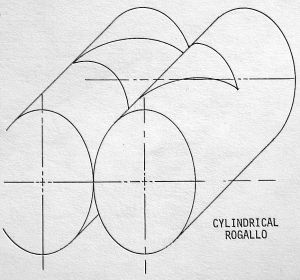
Despite the enormous talent involved with this prototype, the cylindrical Rogallo turned out to be a dead end.
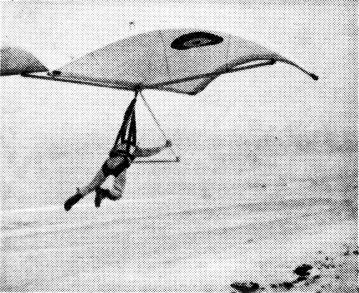
Semi cylindrical Rogallo
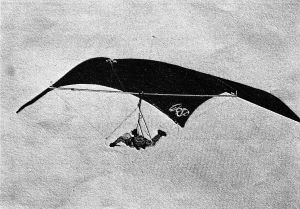
The Seagull III and its copies had parabolic curved leading edges (the tubes were permanently formed into that shape) to reduce washout (span-wise wing twist) without adding sail tension.

Seagull hang gliders with permanently curved leading edges, and in some types curved keel tubes, were manufactured until about 1980.
See the related topics menu Seagull Aircraft of Santa Monica, California.
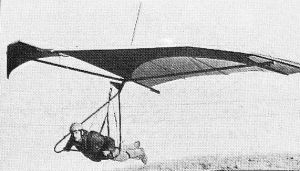
Pliable Moose of Wichita, Kansas, used a segmented leading edge structure instead of curved tubes.
Naming of parts
Today we have naming of parts. Yesterday,
We had daily cleaning. And tomorrow morning,
We shall have what to do after firing. But to-day,
Today we have naming of parts.
— Code breaker Henry Reed, Lessons of the War: I: Naming of Parts, 1942
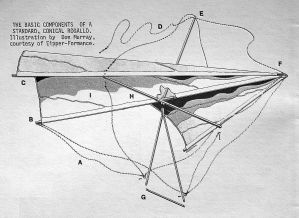
A Flying wires
B Keel tube
C Leading edge
D Top rigging wires
E King post
F Nose plates
G Control frame (including base tube)
H Cross tube
I Sail
Don Murray, creator of this ubiquitous illustration, was editor of the early 1970s color magazine Hang Glider, which featured mainly Leroy Grannis photos, when the SCHGA/USHGA magazine Ground Skimmer was black-and-white only.
Axes of rotation
Axes of rotation are applicable to all direction-controlled moving things, not just Rogallo wings.
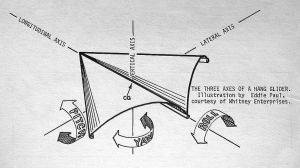
Eddie Paul, creator of this widely used and copied illustration, is best known for designing the unique Whitney PortaWing, which used steel cables in the leading edges instead of alloy tubes. (See under Trial and error in Hang gliding 1973 part 1.)